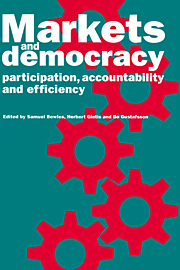Book contents
- Frontmatter
- Contents
- List of figures
- List of tables
- Preface
- 1 Post-Walrasian political economy
- Part I Agency, incentives, and democratic accountability
- Part II Institutions and institutional change
- Part III Conditions for the success of the democratic firm
- 8 After the employment relation: problems on the road to enterprise democracy
- 9 Unions versus cooperatives
- 10 Demand variability and work organization
- 11 Democracy versus appropriability: can labor-managed firms flourish in a capitalist world?
- Part IV Productivity, distribution, and power
- Part V Ownership, participation and capital markets
- Part VI Political democracy and economic democracy
- Bibliography
- Author index
- Subject index
9 - Unions versus cooperatives
Published online by Cambridge University Press: 05 March 2012
- Frontmatter
- Contents
- List of figures
- List of tables
- Preface
- 1 Post-Walrasian political economy
- Part I Agency, incentives, and democratic accountability
- Part II Institutions and institutional change
- Part III Conditions for the success of the democratic firm
- 8 After the employment relation: problems on the road to enterprise democracy
- 9 Unions versus cooperatives
- 10 Demand variability and work organization
- 11 Democracy versus appropriability: can labor-managed firms flourish in a capitalist world?
- Part IV Productivity, distribution, and power
- Part V Ownership, participation and capital markets
- Part VI Political democracy and economic democracy
- Bibliography
- Author index
- Subject index
Summary
Introduction
Why are labor unions in industrialized market economies more common than worker-owned firms? Throughout most of the nineteenth century, the primary goal of the labor movement was to build an alternative economy of cooperative associations that would eventually replace capitalist-owned enterprises. The dominant figure in the first wave of union growth in England in the 1830s was Robert Owen with his schemes of “villages of cooperation” and worker-managed factories. Among working class leaders in France in the 1860s, Pierre-Joseph Proudhon's anarchist vision of a society of decentralized producer cooperatives was far more influential than the socialism of Karl Marx. Even the German Social Democratic Party program called for government aid for the creation of workers' cooperatives until the adoption of the Erfurt Program in 1891 (Lindemann, 1983).
In the last decades of the nineteenth century, Marxists, who insisted that socialists must be dedicated to the attainment of political power, replaced the anarchists and communitarian socialists as leaders of the emerging working class movement (Przeworski and Sprague, 1986). However, it was not the socialist or social democratic party alone that triumphed as the expression of workers' hopes, but the combination of parties in the electoral arena and unions in the labor market. By 1980, union membership averaged 54 percent of the labor force in advanced industrial societies (Wallerstein, 1989). In contrast, membership in worker-owned firms in 1980 comprised only 2.5 percent of the non-agricultural labor force in Italy; even less in other European countries (Ben-Ner, 1988a, 1988b).
A plausible explanation of the success of union organizing relative to the formation of cooperatives is that organizing unions was easier. Establishing worker-owned firms requires capital to invest. Establishing unions requires militants.
- Type
- Chapter
- Information
- Markets and DemocracyParticipation, Accountability and Efficiency, pp. 148 - 158Publisher: Cambridge University PressPrint publication year: 1993
- 3
- Cited by

